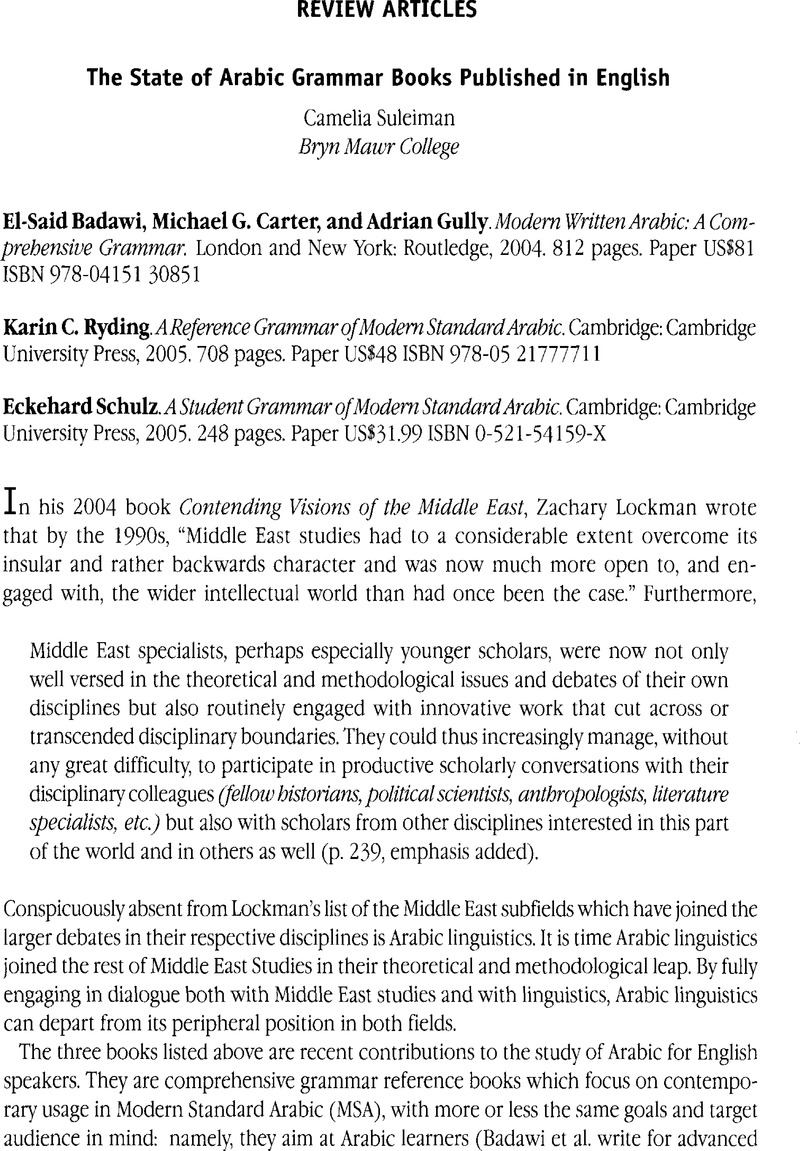No CrossRef data available.
Article contents
The State of Arabic Grammar Books Published in English - El-Said Badawi, Michael G. Carter, and Adrian Gully. Modern Written Arabic: A Comprehensive Grammar. London and New York: Routledge, 2004. 812 pages. Paper US$81 ISBN 978-04151 30851 - Karin C. Ryding. A Reference Grammar of Modern Standard Arabic. Cambridge: Cambridge University Press, 2005. 708 pages. Paper US$48 ISBN 978-05 21777711 - Eckehard Schulz. A Student Grammar of Modern Standard Arabic. Cambridge:Cambridge University Press, 2005. 248 pages. Paper US$31.99 ISBN 0-521-54159-X
Published online by Cambridge University Press: 09 March 2016
Abstract

- Type
- Review Articles
- Information
- Copyright
- Copyright © Middle East Studies Association of North America 2008
References
End Notes
1 Lockman, , Contending Visions of the Middle East: The History and Politics of Orientalism, (Cambridge University Press, 2004), p. 239.CrossRefGoogle Scholar
2 See for example the linguist Labov, William, The Social Stratification of English in New York City (Washington D.C.: Center for Applied Linguistics, 1966), and idem, Sociolinguistic Patterns (Philadelphia: University of Pennsylvania Press, 1972) on the concept of ‘Observer’s paradoxGoogle Scholar.’ See also Harris, Roy, The Language Makers (Ithaca, NY: Cornell University Press), and Rabinow, Paul, Reflections on Field Work in Morocco (Berkeley: University of California Press, 1977).Google Scholar
3 See Lockman, Zachary, Contending Visions of the Middle East.Google Scholar
4 Wright, William, A Grammar of the Arabic Language, 3rd edition, 2 volumes in one (Cambridge: Cambridge University Press, 1967 reprint).Google Scholar
5 Cantarino, Vincente, The Syntax of Modern Arabic Prose, 3 vols. (Bloomington: Indiana University Press, 1974).Google Scholar
6 Ibid.
7 Ibid, p. 48.
8 Ibid, p. 67.
9 Ibid, p. 77.
10 This observation was noted to me by my student Kenya Torres.
11 Edward, Said, Orientalism, (New York: Vintage Books, 1978), p. 123.Google Scholar
12 O’Connell, Daniel C. and Kowal, Sabine, Spontaneous Spoken Discourse: Research and Theory (Springer publisher, forthcoming, 2008).CrossRefGoogle Scholar
13 See for example Chafe’s, Wallace treatment of orality and literacy in “Integration and Involvement in Speaking, Writing, and Oral Literature,” in Tannen, Deborah (ed.) Spoken and Written Language: Exploring Orality and Literacy (Norwood, New Jersey: Ablex, 1982), pp. 35–52.Google Scholar
14 Bakhtin, Mikhail, The Dialogic Imagination (Austin, Texas: University of Texas Press, 1981)Google Scholar
15 Linell, Per, Approaching Dialogue (Amsterdam/Philadelphia: John Benjamins Publishing Company, 1998). Linell (p. 9) defines dialogism as “any dyadic or polyadic interaction between individuals who are mutually co-present to each other and who interact through language (or some other symbolic means)CrossRefGoogle Scholar.”
16 Linell, , The Written Language Bias in Linguistics (New York: Routledge, 2005), p. 214.CrossRefGoogle Scholar
17 Suleiman, Camelia and O’Connell, Daniel C., “Bill Clinton on the Middle East: Perspective in Media Interviews,” Studies in Language and Capitalism, 2 (2007), pp. 75–100Google Scholar, and also Suleiman, Camelia and O’Connell, Daniel C. “Gender differences in the media interviews of Bill and Hillary Clinton,” Journal of Psycholinguistic Research, 37 (2008), pp. 33–48.CrossRefGoogle ScholarPubMed
18 Bakhtin, , The Dialogic Imagination, p. 279, “the word is born in dialogueGoogle Scholar.” See also O’Connell, Daniel C. and Kowal, Sabine, “Psycholinguistics: A Half Century of Monologism,” American Journal of Psychology 116 (2003), pp. 191–212CrossRefGoogle ScholarPubMed; Linell, , Approaching Dialogue; and Suleiman, Camelia and O’Connell, Daniel C., “Gender differences,” (2008).Google Scholar
19 Cotter, Colleen, “Discourse and Media,” in The Handbook of Discourse Analysis, Schiffrin, Deborah, Tannen, Deborah and Hamilton, Heidi (eds.), (Malden, MA, and Oxford: Blackwell, 2001).Google Scholar
20 Bell, Allan and Garrett, Peter (eds.), Approaches to Media Discourse (Oxford: Blackwell, 1999), pp. 4–5.Google Scholar
21 See BohasG, G,, Guillaume, J. P., and Kouloughli, D. E., The Arabic Linguistic Tradition (London and New York: Routledge, 1990), p. 96.Google Scholar
22 See Versteegh, Kees, The Arabic Language (Edinburgh: Edinburgh University Press, 1997)Google Scholar for a general overview of how Arabic linguistics developed in medieval times.
23 Ferguson, Charles, “Diglossia,” in Language Structure and Language Use: Essays by Charles Ferguson,Google Scholar selected and introduced by Dil, Anwar, (Stanford, CA: Stanford University Press, 1971 [1959]), pp. 1–26Google Scholar. See also Badawi, El-Said, Mustawayat al- arabiya ai-Mu ‘asira, Levels of Contemporary Arabic. (Cairo: Dar al-Ma‘arif, 1973).Google Scholar
24 Koch, P. and Oesterreicher, W., “Schriftlichkeit und SpracheGoogle Scholar,” in Günther, H. and Ludwig, O. (eds.), Schrift und Schriftlichkeit. Writing and its Use. Ein interdisziplinäres Handbuch internationaler Forchung. An Interdisciplinary Handbook of International Research (Berlin: De Gruyter, 1994), pp. 587–604Google Scholar. See also O’Connell, Daniel C. and Kowal, Sabine, “Orality and Literacy in Public Discourse: An Interview of Hannah Arendt,” Journal of Pragmatics, 30 (1998), pp. 543–564;Google Scholar and Ferguson, Charles, “Diglossia,” and “Diglossia revisited,” The Southwest Journal of Linguistics, vol. 10, no. 1 (1991), pp. 214–233.Google Scholar
25 See for example Holes, Clive, Modern Arabic: Structures, Functions and Variations (Washington D.C.: Georgetown University Press, 2004).Google Scholar
26 Bakhtin, Mikhail, “The Problem with Speech Genres,” in Jaworski, Adam and Coupland, Nikolas (eds.), The Discourse Reader (London and New York: Routledge, 1999), p. 132.Google Scholar
27 Ibid, p. 121.
28 One search on ‘You Tube’ of the young poet Tamim Barghouti shows more than 400,000 hits for one of his poems. This reaches far more people than most Arabic newspaper circulations.
29 Taylor, Talbot, Theorizing Language: Analysis, Normativity, Rhetoric, History (Amsterdam: Pergamon, 1997), pp. 59–60, as cited in Linell, Per, The Written Language Bias in Linguistics: Its Nature, Origins and Transformation, p. 30.Google Scholar
30 Ibid.
31 See Haeri, Niloofar, Sacred Language, Ordinary People (New York: Palgrave, Macmillan, 2003)Google Scholar, though Haeri remains essentialist in her characterization of Cairene Arabic.




